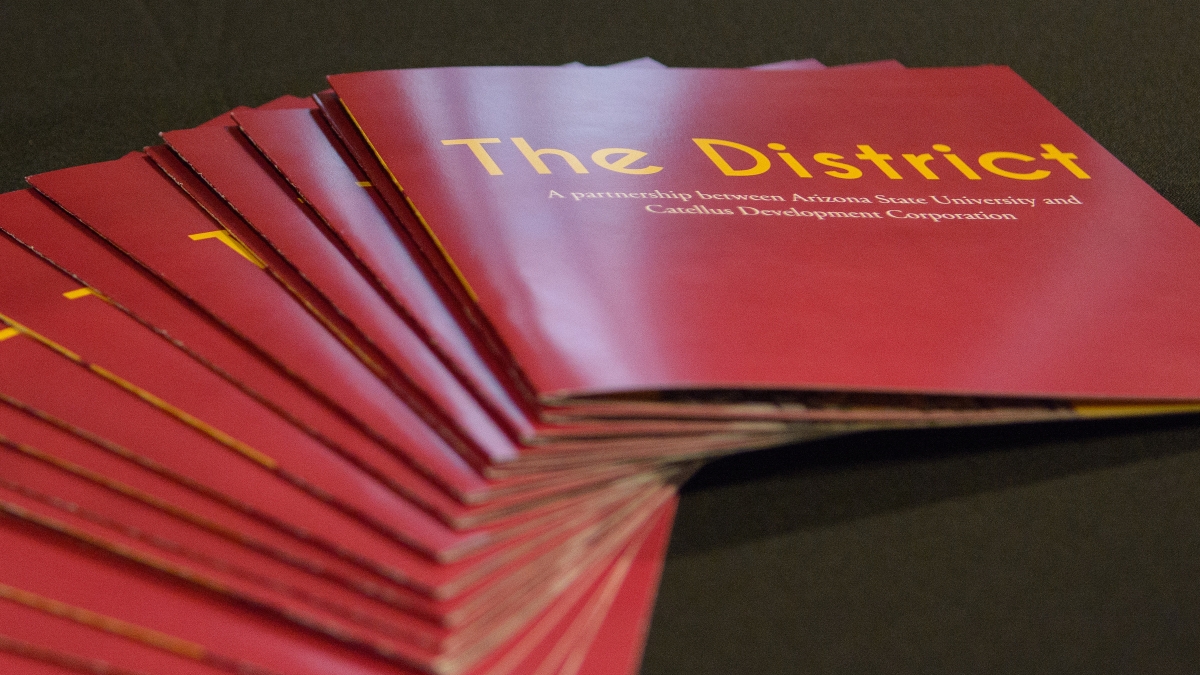ASU, Catellus partner to develop mixed-use athletic district

Arizona State University has announced its selection of Catellus Development Corporation as master developer for the ASU Athletic Facilities District, a unique, mixed-use development on 330 acres at the northeast end of ASU’s Tempe campus.
The district, envisioned as a model for creative urban neighborhood design and sustainable development, will be enlivened by its proximity to the nation’s largest public research university, a vibrant downtown Tempe and major collegiate and amateur sports venues. The development will supply a revenue stream for university athletics facilities at ASU.
“With a strong partner in the City of Tempe, a unique location and the unlimited potential of the young men and women who graduate from ASU every year, this project should be one of the most attractive sites for development in the nation,” said ASU President Michael M. Crow. “We look forward to working with Catellus and leaders throughout the city and the region to build out this vital new part of Tempe.”
Originating from legislation passed by the state legislature in 2010 to create special revenue districts on land owned by state-supported universities, the district will provide financial returns to the university while delivering significant, tangible economic impact for the City of Tempe. The 2010 legislation authorizes such districts to impose an assessment, in lieu of property taxes, to be used to construct and improve intercollegiate athletic facilities. ASU is the first state university to act on this opportunity.
Catellus, based in Oakland, California, brings to the district more than 30 years experience as a master developer in projects across the country. The company has transformed former airports, military bases and urban industrial sites into thriving retail, residential and commercial communities.
“This is an amazing opportunity and an outstanding piece of real estate in an extremely visionary city,” said Ted Antenucci, CEO of Catellus. “What makes it even better is the kind of partners we have in ASU and the City of Tempe. ASU is on the cutting edge of sustainability education, giving us the chance to set an even higher standard for the sustainable planning and building practices that have long been a fundamental component of how Catellus develops."
Antenucci said Catellus expects more partners to emerge locally and nationally.
“It’s very exciting to be a part of this with such a dynamic university partner, and we expect other local and national developers to play a role in helping this project evolve over the next 20 years,” Antenucci said.
The district will boast unparalleled transportation access, being 1.5 miles from Phoenix Sky Harbor Airport, the fifth busiest airport in the country; a quarter-mile from a full interchange of the Loop 202 Freeway; adjacent to the Loop 101 Freeway and fully developed adjacent arterial street systems, and easily accessible via the Valley’s 20-mile-long light rail system.
The selection of Catellus comes after a two-year process that included requests for qualifications, business plans and multiple interviews with potential developers.
“We’ve worked diligently for the past two years with the close counsel of our partners at the City of Tempe to select the right development partner,” said Morgan R. Olsen, ASU’s executive vice president, treasurer and chief financial officer. “Catellus has an outstanding track record, and its values are aligned with ours on issues of sustainability, social and environmental value, and urban development. With their help, the district will be an asset not just for the university, but also a major employment and economic development asset for Tempe and the Valley.”
The next steps will involve careful study and planning, according to both Catellus and ASU.
John Creer, ASU assistant vice president for university real estate development, said the district development will be a long-term project over the next 10 to 20 years, with the potential for seven to 11 million gross square feet of development. He said expectations are for a mixed-use district that will include multifamily residences, commercial development and service retail. The first step will be a public planning process over the next six to nine months.
“We have a long way to go, and this is just the beginning,” Creer said. “No decisions have been made about what happens or where things go. What comes first is studying the infrastructure needs of this large piece of property and understanding the market conditions of what is possible. We will have a public planning process with meetings, open houses and community engagement – it’s going to be a collaborative process.”
Tempe Mayor Mark Mitchell said the district offers Tempe an opportunity unlike any other in the Valley.
“Today marks the beginning of a new and exciting opportunity for the City of Tempe,” Mitchell said. “The investments we’ve made in this community, our partnership with this world-class research university and the proximity of the district to Tempe Town Lake make this a project with unparalleled potential. We welcome Catellus and look forward to working together for many years into the future.”

